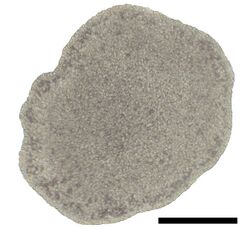Biology:Cladtertia
| Cladtertia | |
|---|---|

| |
| Microscopic image of Cladtertia collaboinventa. Scale bar is 0.2 mm. | |
| Scientific classification | |
| Domain: | Eukaryota |
| Kingdom: | Animalia |
| Phylum: | Placozoa |
| Class: | Uniplacotomia |
| Order: | Hoilungea |
| Family: | Cladtertiidae Tessler et al., 2022 |
| Genus: | Cladtertia Tessler et al., 2022 |
| Species: | C. collaboinventa
|
| Binomial name | |
| Cladtertia collaboinventa Tessler et al., 2022
| |
Cladtertia is a genus of placozoan discovered in 2022, whose only currently described species is Cladtertia collaboinventa. However, the genus is known to contain several other species, awaiting a formal description. Its closest described relative is Hoilungia hongkongensis, with whom it forms the order Hoilungea. After Trichoplax, Hoilungia and Polyplacotomia, it is the fourth described placozoan genus (and species) up to date.[1]
Etymology
The genus name comes from Ancient Greek kládos (clade) and Latin tertius (the third), referring to its specimens previously being assigned to placozoan Clade III in literature.
Reproduction
Uniquely among placozoans, sexual reproduction has been reported to occur in the placozoan clade identified with strain H8,[2][3] which was later found to belong to genus Cladtertia.[1] Intergenic recombination was observed, as well as other hallmarks of sexual reproduction such as sharing of alleles between heterozygous and homozygous individuals.
References
- ↑ 1.0 1.1 Tessler, Michael; Neumann, Johannes S.; Kamm, Kai; Osigus, Hans-Jürgen; Eshel, Gil; Narechania, Apurva; Burns, John A.; DeSalle, Rob et al. (2022-12-08). "Phylogenomics and the first higher taxonomy of Placozoa, an ancient and enigmatic animal phylum". Frontiers in Ecology and Evolution 10. doi:10.3389/fevo.2022.1016357.
- ↑ Signorovitch, A.Y.; Dellaporta, S.L.; Buss, L.W. (2005). "Molecular signatures for sex in the Placozoa". Proceedings of the National Academy of Sciences of the United States of America 102 (43): 15518–22. doi:10.1073/pnas.0504031102. PMID 16230622. Bibcode: 2005PNAS..10215518S.
- ↑ Charlesworth, D. (2006). "Population genetics: Using recombination to detect sexual reproduction: The contrasting cases of Placozoa and C. elegans". Heredity 96 (5): 341–342. doi:10.1038/sj.hdy.6800809. PMID 16552431.
Wikidata ☰ Q117527299 entry
 |

